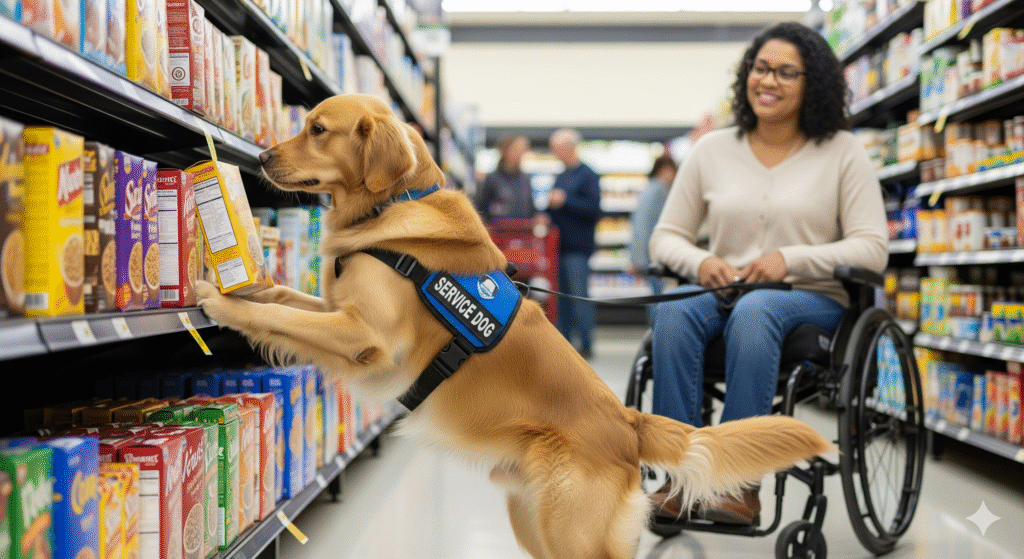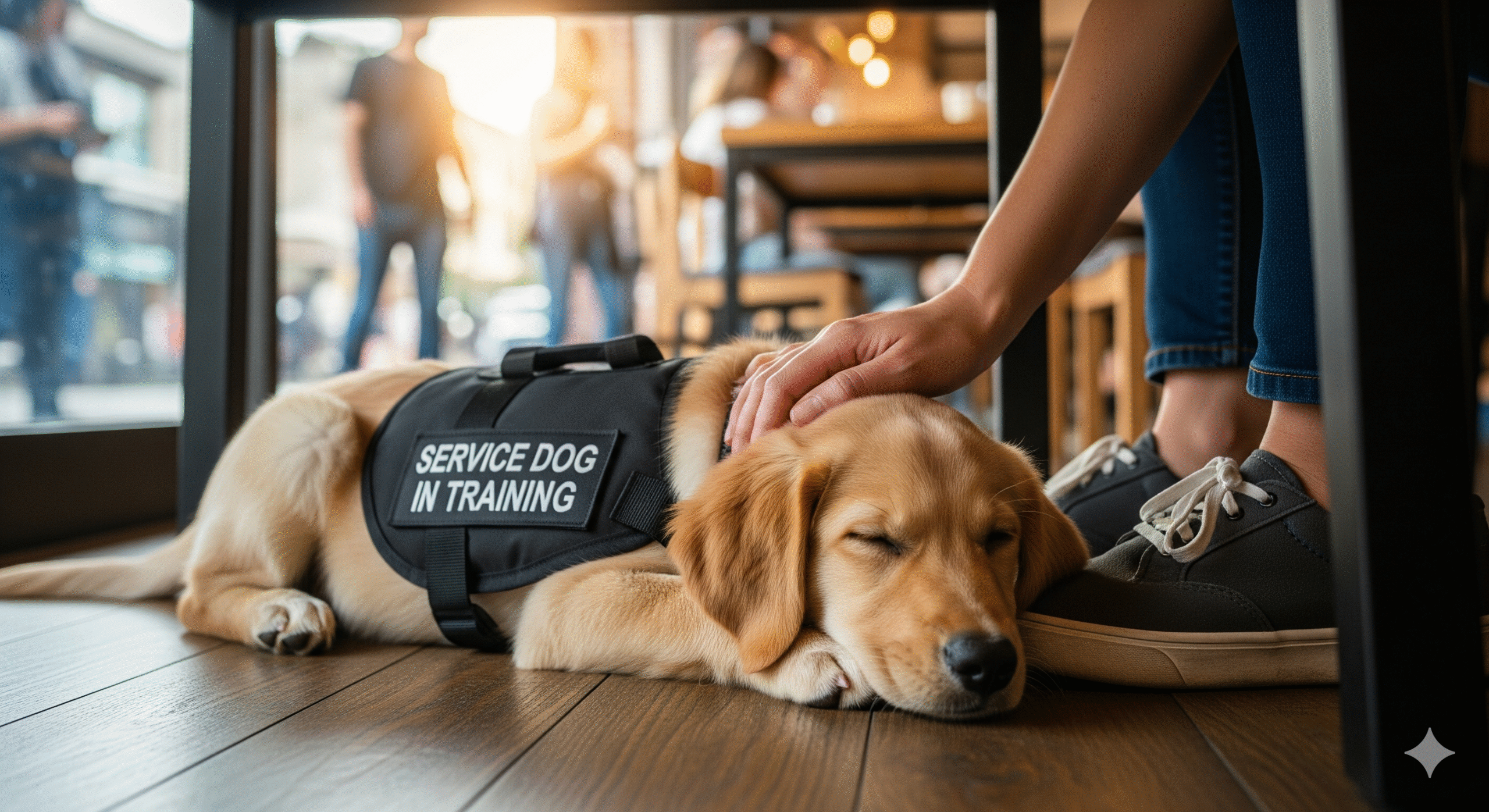Training a service dog is a profound commitment that begins the moment you bring your puppy home. This journey is about far more than teaching basic obedience; it’s about cultivating a specific temperament—one of unwavering focus, impeccable public manners, and a deep desire to work—that will enable them to perform life-changing tasks for their handler. The first year of a service dog puppy’s life is dedicated to building an unshakable foundation. Rushing this process or cutting corners almost guarantees that the dog will “wash out” or fail to meet the rigorous standards required for public access work.
This guide outlines the critical first steps in this rewarding journey. We’ll focus on the foundational pillars of socialization, obedience, and public access manners that every potential service dog must master before task-specific training can even begin.
Here’s what we’ll cover:
✔️ The core temperament traits that make a suitable service dog candidate
✔️ The critical socialization window and how to do it correctly for a service dog
✔️ Foundation obedience skills that are non-negotiable
✔️ Introduction to public access training and desensitization
✔️ The importance of neutrality in a working dog
✔️ How to start shaping specific tasks (retrieval, alerting, etc.)
✔️ The reality of “wash rates” and knowing when a dog isn’t suited for work
Let’s lay the groundwork for a confident, capable, and compassionate working partner.
Temperament First: Is Your Puppy a Good Candidate? 🧠
Not every puppy has the temperament for service work. The ideal candidate possesses:
- Calm Confidence: They should be curious and engaged but not easily excited or fearful. A dog that is startled by sudden noises or avoids novel situations will struggle in public settings.
- Biddability (Want-to-Please Attitude): The puppy should genuinely enjoy working with you and be highly motivated by praise, toys, or food. A stubborn or independent puppy is a poor fit.
- Soundness: They should be physically healthy with no signs of structural issues that could be exacerbated by work.
- Neutrality: A service dog must ignore other people, dogs, and environmental distractions. A puppy that is overly friendly or reactive to other animals will not be able to focus on its handler.
Many service dog organizations have a 50-70% “wash out” rate, often due to temperament issues that emerge during this early phase.
Pillar 1: Extreme Socialization & Environmental Neutrality 🌍
For a service dog, socialization isn’t just about having positive experiences; it’s about learning to be neutral and undisturbed by the human world.
- Goal: Create a puppy that is “bombproof” and can remain focused on its handler in any environment.
- Method: Pair every new experience with high-value rewards. The puppy should learn that novel things predict good things (chicken!).
- Places to Go (before 16 weeks): Hardware stores, shopping malls (in a cart), schools (at pickup time), buses, trains, hospitals (quiet areas), restaurants with patios, and busy city streets.
- Things to Experience: Wheelchairs, crutches, elevators, escalators (carry them), automatic doors, loud noises, people in uniforms, and crowds.
The outcome of successful socialization is a dog that observes the world calmly but is primarily focused on you.
Pillar 2: Impeccable Foundation Obedience 🎓
These skills must be rock-solid and performed reliably, even with distractions.
- Automatic Check-Ins/Focus: The dog should voluntarily look to you for guidance in new situations. This is the most important skill.
- Loose-Leash Walking: The dog must walk politely without pulling, regardless of the environment.
- Long-Duration Stays: A “down-stay” for 30+ minutes is essential for restaurants, meetings, and classes.
- “Leave It”: Must be 100% reliable for dropped food, medications, or other hazards.
- Solid Recall: In case of an emergency, you must be able to call your dog back to you instantly.
Pillar 3: Public Access Manners & Desensitization 🏙️
This is where service dog training diverges from pet training. The dog must learn to be invisible in public.
- Tucking: Teaching the dog to curl up tightly under chairs, tables, and in tight spaces.
- Ignoring Environmental Distractions: Practice obedience skills while people drop things, jog by, or approach you (without petting).
- Desensitization to Handling: The dog must tolerate being brushed against, having their feet stepped on lightly, and being examined by strangers (as a doctor might).
- Potty on Command: This is a critical skill for maintaining hygiene and predictability in public.
Pillar 4: Introduction to Task Work ⚙️
Task training is built upon a solid foundation of obedience and focus.
- Retrieval: The foundation for many tasks. Start by teaching a solid “hold” and “give” with various objects.
- Targeting: Teaching the dog to touch a target with its nose or paw. This can be used to alert to sounds, close doors, or turn on lights.
- Alert Behaviors: Shaping a natural behavior (like a nudge) into a specific alert for a medical condition.
- Mobility Work: Warning: Any task involving weight-bearing (bracing, forward momentum pull) should ONLY be taught by a professional and with a vet’s clearance after the dog is fully grown (2+ years old). Puppies can be taught the cues without any weight.
What to Avoid: Common Training Mistakes ❌
- Using Aversives: Punishment-based training creates anxiety and undermines the trust required for a service dog partnership.
- Rushing Public Access: Do not take your dog into non-pet-friendly stores until they have mastered basic obedience in distracting pet-friendly locations.
- Neglecting Settling: A service dog must have an “off switch.” Practice calm settling in various environments daily.
- Letting Strangers Pet: Politely inform people that your dog is “in training” and cannot be petted. This is essential for maintaining their focus on you.
Final Checklist for Service Dog Puppy Foundations ✅
☑️ My puppy has a calm, confident temperament suitable for work.
☑️ I have a rigorous socialization plan to expose them to 100+ environments.
☑️ I am proofing basic obedience commands in increasingly distracting settings.
☑️ I am working on tucking and settling in busy places.
☑️ I understand that task training comes after rock-solid foundations.
☑️ I am prepared for the possibility that this puppy may not be suited for work.

The goal of socialization is to give your puppy positive experiences in a variety of environments. Taking them on walks through your neighborhood, to the park, or to pet-friendly stores is a huge part of this. To do all of that safely and calmly, your puppy first needs to master walking politely by your side. Our Leash Training a Puppy: Step-by-Step Walk Guide is the perfect place to start.






